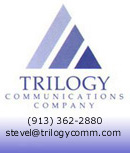
Strategic Planning Facilitation
The Philosophy Behind the Trilogy Strategic Planning Process
The Trilogy Strategic Planning Process offers two key deliverables: First, you'll have an easily understood, simple, actionable strategic plan. Second, the plan will be developed by the same people who will be charged with implementing the plan. The result? A dynamic plan that can be used to shape future growth rather than a plan that gathers dust on the shelf.
How can we make that promise? Much of our strategic planning facilitation success derives from the philosophy behind the process.
We have three simple beliefs about developing a good strategic plan:
- The thicker
the plan, the less likely it'll be used. There's a direct, inverse
correlation between the thickness of the plan and the number of times
it's actually consulted. Shorter, simpler and sweeter always equals
better.
- Somebody else's
plan is worse than no plan.
If the people most affected by the plan aren't intimately involved in
its creation, the plan has very low credibility and value. The more
your people are involved in the plan's development, the greater the
value of your plan.
- The strategic planning process should be enlightening – not tortuous. While certainly not everyone's idea of great fun, assembling the right group of people to develop a meaningful plan should provide new insights and more than a few "ahas" along the way. And at times, it should be fun!
The Trilogy Strategic Planning Process
The Trilogy Process is divided into four distinct sessions. We often do these sessions in one two-day period . . .some clients prefer to do two one-day sessions . . . . and yet others prefer to do four 4/5-hour periods. No matter how you may want to divide or combine the sessions, here's how we'll structure the development of your final plan:
Session I:
- review of service/product line goals, objectives, vision, mission
- completion of a SOT/IWIK analysis (strengths, opportunities, threats and I wish I knew....)
- positioning overview vis a vis competitors, clients, and potential clients
Session II:
- overview potential strategies and their value to the service/product lines
- review, revise, agree upon potential strategies
Session III:
- identify key foundations needed to implement the chosen strategies
- review, revise strategies and key foundations
Session IV:
- outline tactics/responsible parties and completion dates for each strategy/foundation
We've seen great success in facilitating these sessions in the evenings. Sessions from 4 or 5 p.m. to 8 or 9 p.m. work well. We generally work through a simple dinner and keep the momentum flowing throughout the session.
Our recommendation is to allow for a reasonable length of time between sessions for ideas and thoughts to marinate. Weekly sessions – or at least a few days between the sessions – seem to work best.
The Trilogy moderator's job is threefold: to facilitate; to play the devil's advocate when necessary; and to offer suggestions and ideas based on the moderator's background and experience – that's the "value added" you receive from the Trilogy facilitator and process.
Along the way, we'll work from flip charts. This is a low-tech process – we'll need only a flip chart easel, a couple of blank flip chart pads, some masking tape and some wall space. These materials are just the tools – the real work is done with the participants' brains and hearts.
At the end of each session the facilitator will compile, organize and synthesize the information and return it to you for distribution to your management team.
Who Should Participate?
The answer is simple. Participants should be the same people charged with implementing the plan. Certainly senior managers must be at the table. But mid- and lower-level managers should also be involved in the process. Many of the smaller firms that have used this process involve the entire company or entire departments.
The Plan
In the end, what will you have?
First, you'll have a plan that you and your organization prepared. Everyone will have had plenty of opportunities for input. Everyone will have a clear understanding of his/her part in the success of the plan. This will not be an imposed plan developed by an outsider – rather, it will be a team plan developed by and for colleagues and associates.
Second, you'll have a cohesive plan. Each segment will be aimed at achieving a universal, well-recognized goal. You'll be able to focus time, energy and resources on a single target.
Finally, you'll have a plan that's simple. And actionable. The entire plan will fit on a single, 8.5" x 11" piece of paper. Every tactic will carry a completion date and the person responsible for its completion. This will be a tangible plan and the progress can be measured at any point in the year.
Please contact us to learn more about the Trilogy Strategic Planning Process and how it might be applicable to growing your business.
Presentation Skills & Strategy Seminar | Successful Account Management Seminar
Strategic Planning Facilitation | Trilogy Presentation Tips
Participant's Questionnaire | Contact Trilogy
All material copyright (c) 2003 Trilogy Communications Company